Documentation Hub
Explore key publications and ongoing research by CECREH, reflecting our scholarly contributions to the fields of disaster resilience, post-disaster housing recovery, and equitable community development.
Published
Disasters outside of municipal boundaries: A systematic review of the problems, solutions,
and challenges of disaster resilience in tribal lands, colonias, and unincorporated
communities
Danielle Craig, Ali Nejat
Abstract:
It is estimated that around 1/3rd of the US population lives in unincorporated areas
that lie outside of municipal boundaries. Considering the substantial demographic
segment and the increasing incidence of disasters, it is important to understand how
unincorporated communities plan for, respond to, and recover from disasters; however,
limited scholarly attention has addressed this topic with coverage focusing on singular
forms of unincorporated communities, such as colonias and AIAN communities, and no
coverage of unincorporated communities generally. A more comprehensive understanding
of the vulnerability, exposure, risk, and resilience of unincorporated communities
to disasters could allow addressing how these populations can better prepare for,
respond to, and recover from disasters. This systematic review intends to explore
the key problems, solutions, and challenges faced by these communities during different
stages of disaster. The paper concludes with recommendations for how unincorporated
communities can increase resilience and capacity when faced with disasters.
Under review
Longitudinal Housing Recovery Following Hurricane Sandy: A Survival Analysis
Babatunde Lawal, Ali Nejat, Rodrigo Costa, Amin Sobhani, Sara Hamideh, Ashley D. Ross
Abstract:
This study employed a longitudinal approach to analyze housing recovery following
Hurricane Sandy, utilizing survival analysis to assess the time required for property
values to return to or exceed their pre-disaster appraised values. Lots’ appraised
values before the hurricane and across multiple years, post-disaster, were extracted
as proxies for damage severity and recovery progress. The recovery timeline was then
linked to household and housing characteristics to determine their significance in
long-term recovery. Results indicated that households with higher socioeconomic status
and education levels, as well as those residing in older homes, tended to recover
more slowly compared to their counterparts. These findings provide critical insights
into the factors influencing long-term housing recovery, offering valuable guidance
for disaster recovery planning and policymaking at various levels to enhance resilience
and equitable recovery outcomes.
A Systematic Review of Literature on the Utilization of 3D Printing Technologies for
Disaster-Resilient Housing
Paul Iyohaa, Ali Nejat, Sina Mostafavi
Abstract:
The rise in global disasters has highlighted the need for innovative and resilient
housing solutions that can withstand and recover from catastrophic events. Conventional
construction methods are often time-consuming, labor-intensive, costly, and ineffective
in providing adequate resilient housing able to withstand disasters and/or recover
from them. 3D printing technology(3DPT) offers a promising solution for disaster-resilient
housing. However, comprehensive knowledge of their utilization in this specific area
is lacking. This systematic review explores the utilization of 3DPT specifically towards
disaster-resilient housing, encompassing both pre-and post-disaster scenarios through
retrofitting and recovery applications. In pre-and post-disaster applications, 3DPT
offers promising solutions by streamlining construction processes, reducing waste,
and enabling rapid customization of housing solutions. The review identifies critical
barriers in preand post-disaster housing and highlights the transformative potential
of 3DPT in revolutionizing the construction industry. Through an analysis of the literature,
it becomes evident that 3DPT presents opportunities to address significant challenges
often faced by conventional construction methods. The review also conducts a t-distributed
stochastic neighbor embedding (t-SNE) to help with visualizing the emerged clusters
of the gathered reports using Gaussian Mixture Models, topic modeling using latent
Dirichlet allocation, and a SWOT analysis, which reveals strengths such as customizability
and time efficiency while acknowledging weaknesses like high initial investment and
material restrictions. Recommendations for future research include standardization
and code development, material innovation, community engagement, long-term performance
evaluation, and policy and governance considerations. By addressing these research
gaps, 3DPT can maximize their potential to provide sustainable, cost-effective, and
resilient housing solutions for communities worldwide.
RAAbIT: A Recovery Agent-Based Integrated Tool for Post-Disaster Housing Simulation
Rodrigo Costa, Ali Nejat, Sara Hamideh
Abstract:
As climate change increases the frequency and severity of disasters, proactive planning
for post-disaster housing recovery is essential to mitigate long-term social and economic
disruption. Computational models can support this planning by simulating potential
recovery trajectories, yet many existing approaches are limited by overwhelming data
requirements or narrow applicability to past events. Here, we introduce RAAbIT (Recovery
Assessment using Agent-based Tools), a novel agent-based model designed to simulate
housing recovery using data available within weeks of a disaster. RAAbIT models individual
households, insurers, and contractors as agents governed by empirical behavior rules,
and incorporates modifiable system-level constraints, such as contractor availability,
to reflect context-specific recovery dynamics. We demonstrate the model’s utility
by hindcasting two California wildfires—the 2017 Tubbs Fire in Santa Rosa and the
2018 Camp Fire in Paradise—and capturing their divergent recovery trajectories. Despite
similar hazards, the two communities experienced significantly different reconstruction
outcomes, with Santa Rosa rebuilding 57% of destroyed homes and Paradise only 9% within
five years. RAAbIT can reproduce temporal and spatial patterns of recovery observed
in building permit and construction data. By balancing generalizability with data
realism, RAAbIT provides a flexible and transferable tool for post-disaster recovery
planning, supporting more effective decision-making under uncertainty and enhancing
community resilience in the face of escalating climate risks.
Summit Posters
Posters presented at the 2025 CECREH Inaugural Summit, showcasing student and faculty research on climate resilience, housing recovery, and community capacity-building.

Building Local Capacity to Flooding
Danielle Craig, Ali Nejat, Ashley Ross
Explores how unincorporated communities in the Lower Rio Grande Valley build adaptive capacity to flooding, using a system-dynamics and capitals framework to inform local disaster policy and resilience strategies.
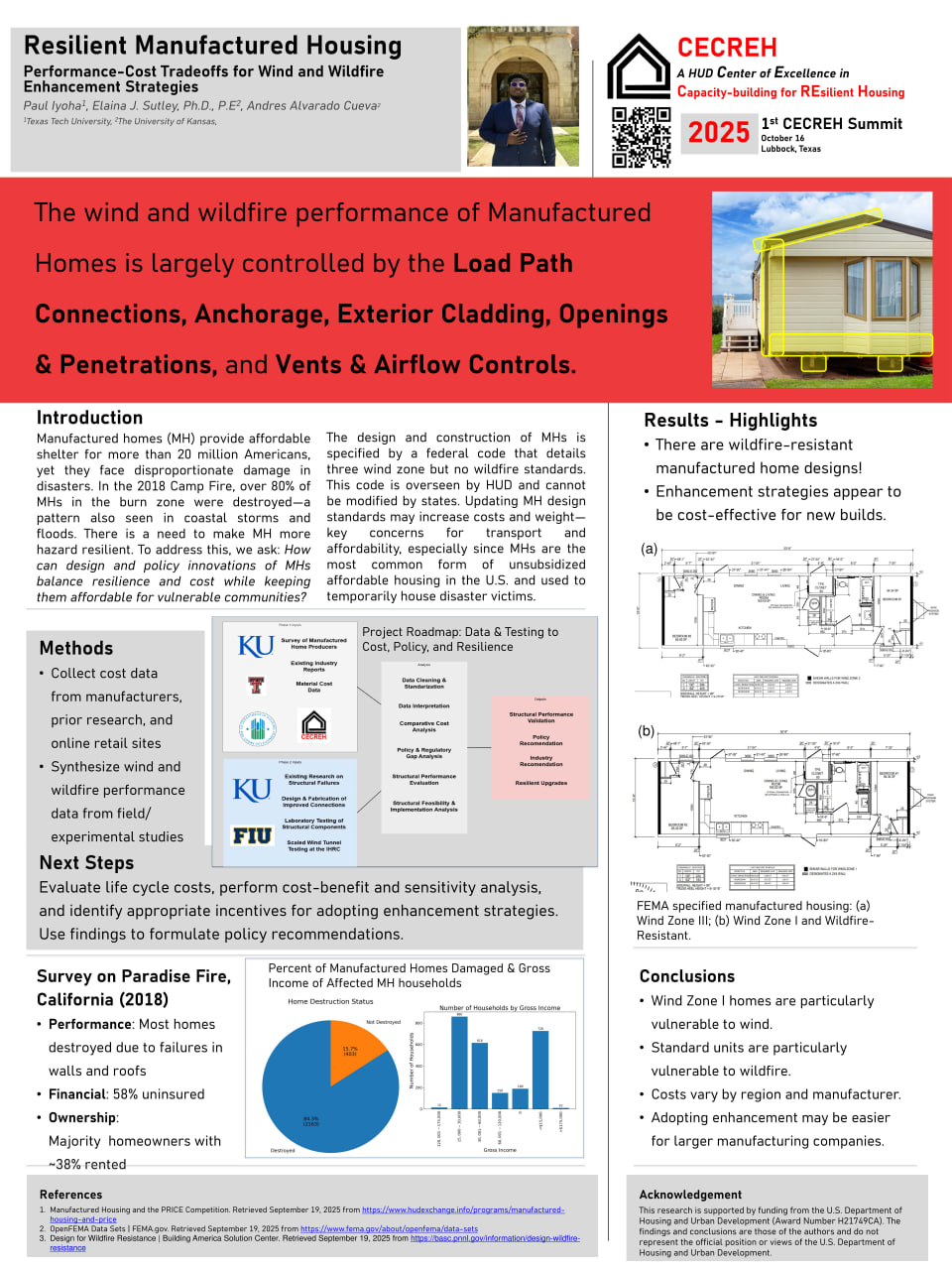
Resilient Manufactured Housing: Performance–Cost Tradeoffs for Wind and Wildfire Strategies
Paul Iyoha, Elaina J. Sutley, Andres Alvarado Cueva
Evaluates how upgrades to load paths, cladding, openings, and ventilation can improve manufactured home performance in wind and wildfire while balancing cost, code requirements, and affordability.
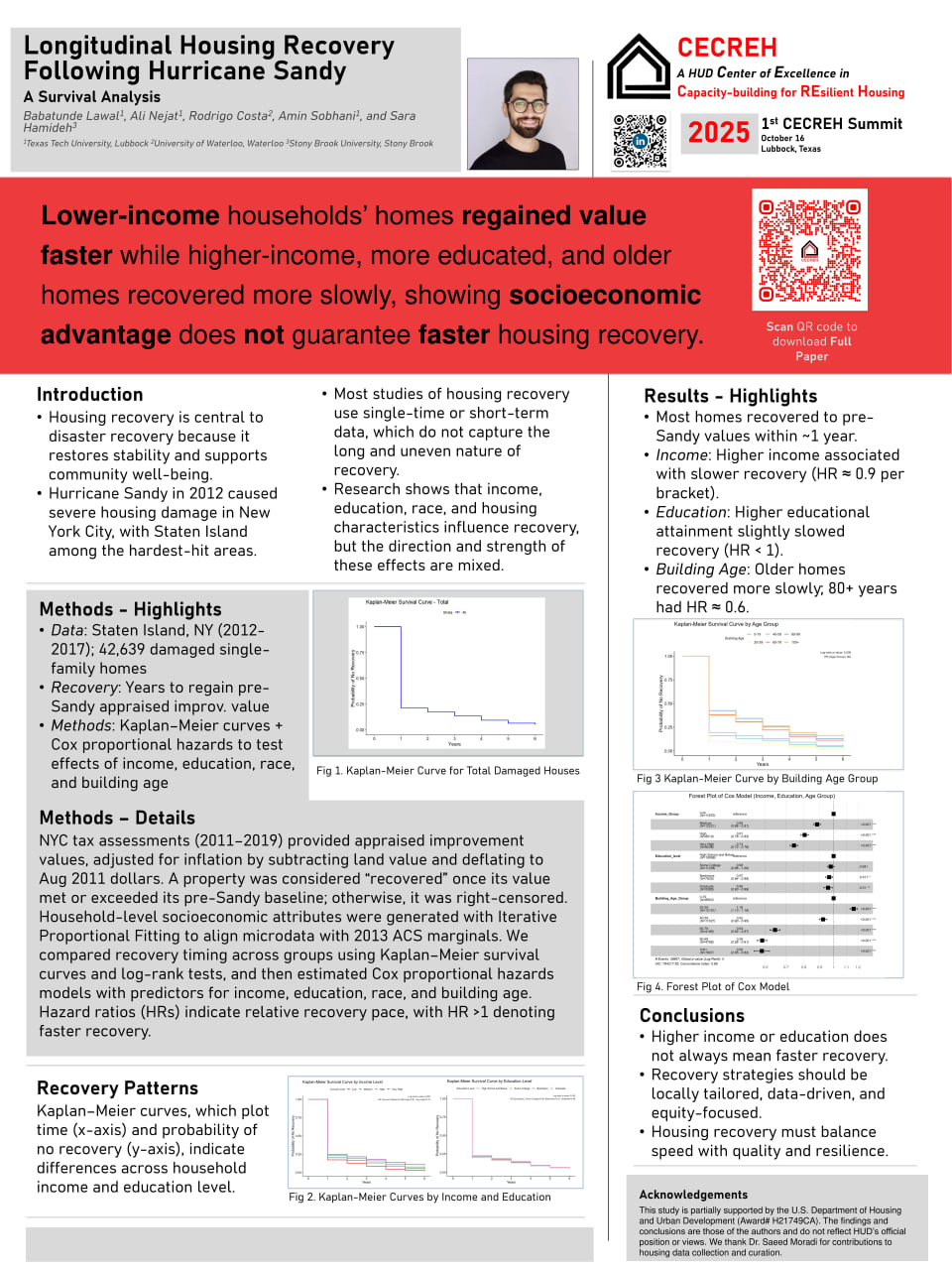
Longitudinal Housing Recovery Following Hurricane Sandy: A Survival Analysis
Babatunde Lawal, Ali Nejat, Rodrigo Costa, Amin Sobhani, Sara Hamideh
Uses survival analysis of property values in New York City to examine how income, education, and housing characteristics shape the pace of long-term housing recovery after Hurricane Sandy.
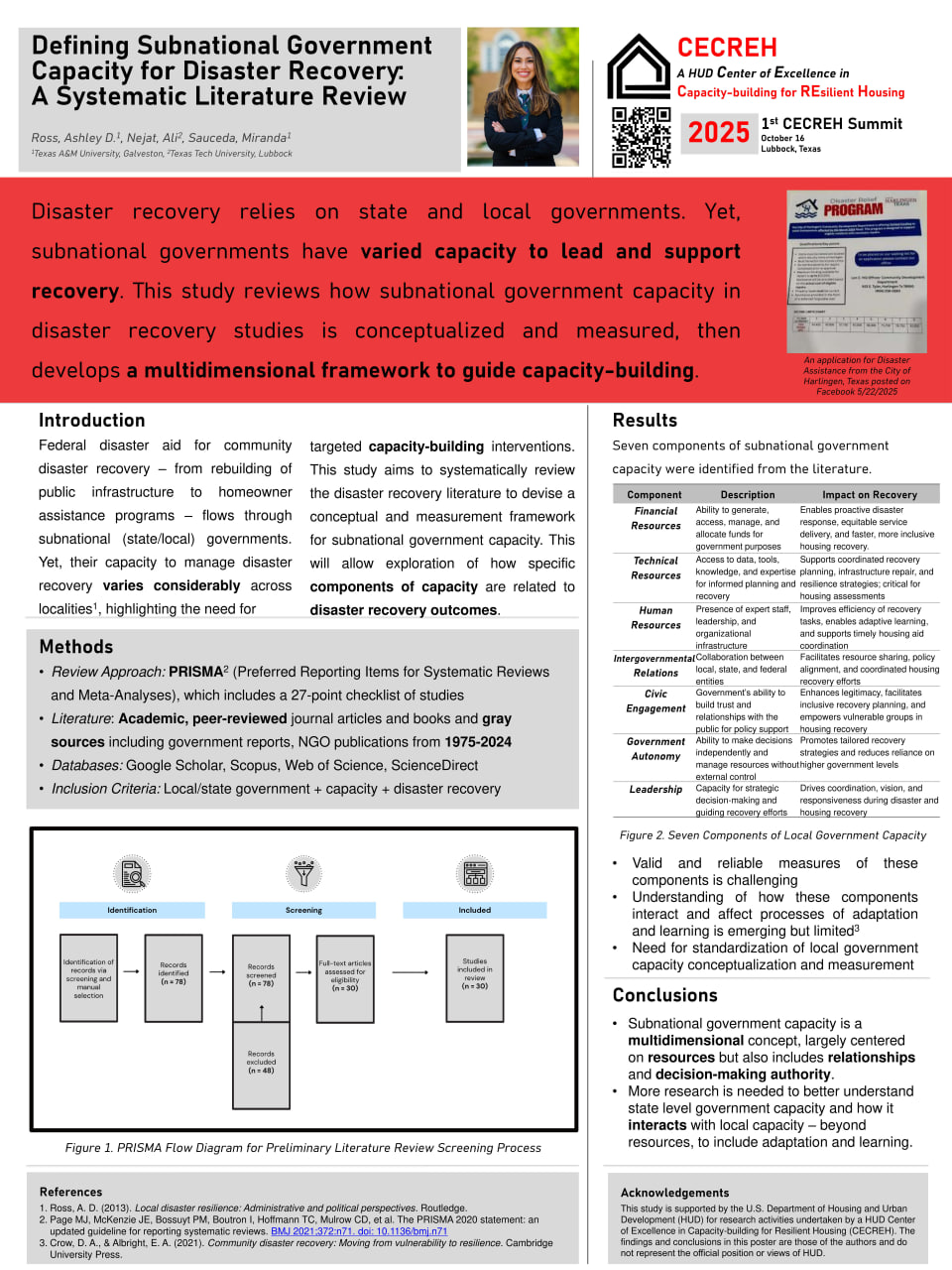
Defining Subnational Government Capacity for Disaster Recovery: A Systematic Literature Review
Ashley D. Ross, Ali Nejat, Miranda Sauceda
Synthesizes disaster recovery research to identify how local and state government capacity is conceptualized and measured, developing a multidimensional framework to guide capacity-building efforts.
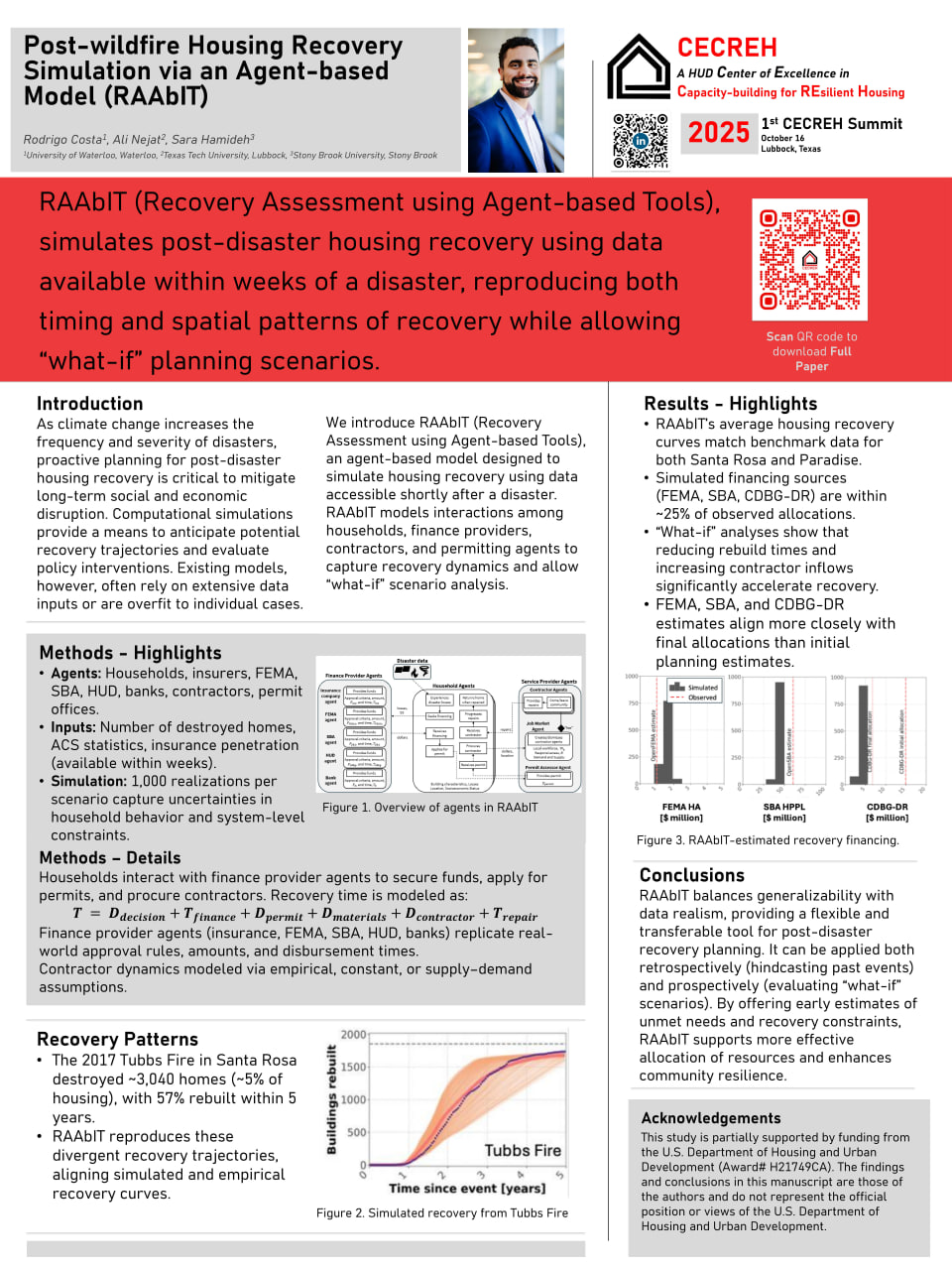
Post-wildfire Housing Recovery Simulation via an Agent-based Model (RAAbIT)
Rodrigo Costa, Ali Nejat, Sara Hamideh
Presents RAAbIT, an agent-based model that uses early post-disaster data to simulate housing recovery, reproducing spatial and temporal rebuilding patterns and enabling “what-if” planning scenarios.
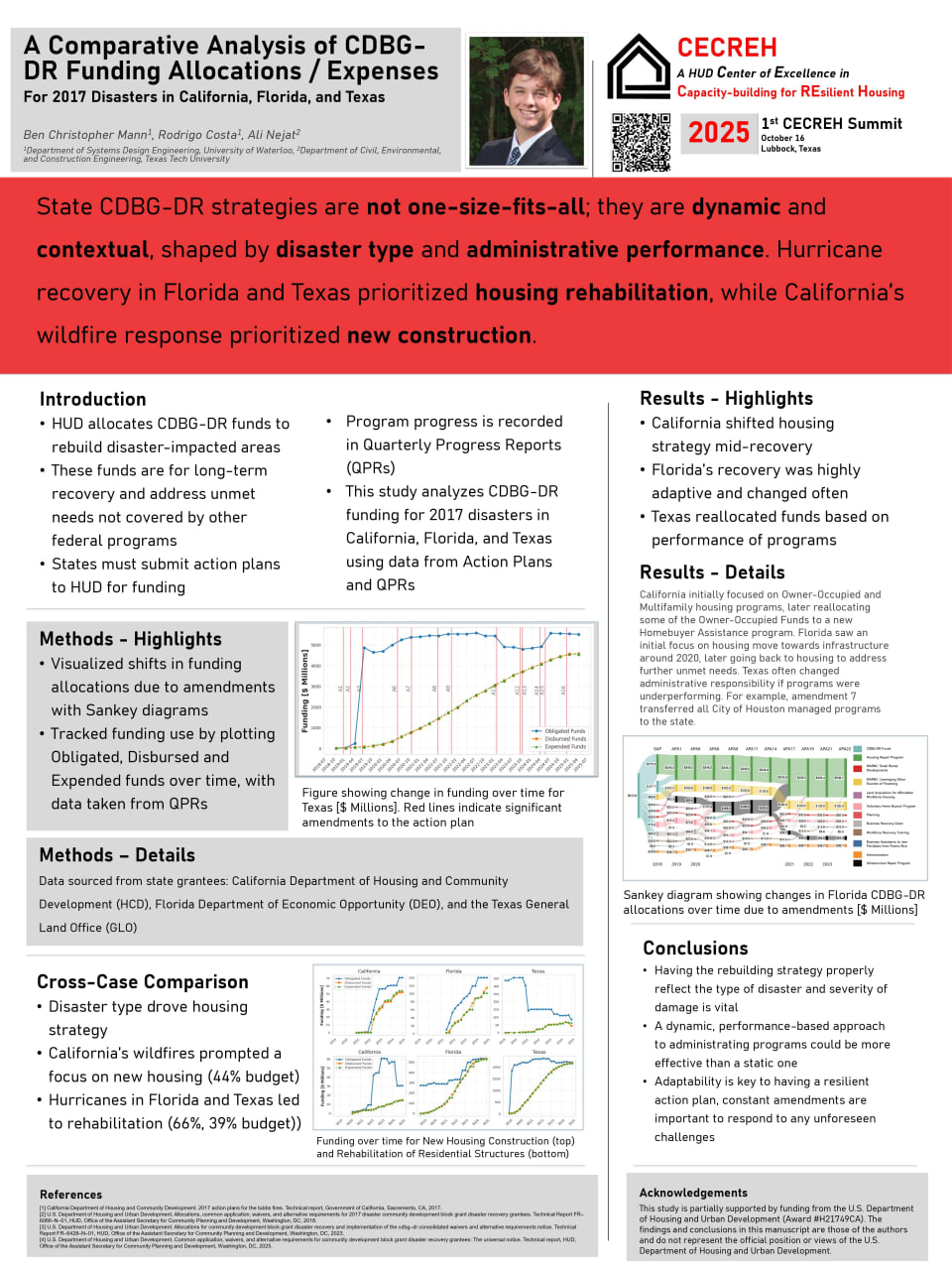
A Comparative Analysis of CDBG-DR Funding Allocations/Expenses for 2017 Disasters in California, Florida, and Texas
Ben Christopher Mann, Rodrigo Costa, Ali Nejat
Analyzes how state CDBG-DR strategies vary by disaster type and administration, comparing shifts in housing rehabilitation and new construction funding across three states and their recovery programs.

Surrogate Modeling of Flood-Induced Housing Damage: Harvey, Severe Spring Storms, and Irma
Temidayo Popoola, Ali Nejat, Babatunde Lawal, Katharine Hayhoe, Hussein Orekoya
Uses machine-learning models to link hazard, vulnerability, and exposure measures to housing damage across multiple flood events, highlighting key drivers of risk at different spatial scales.
Center of Excellence in Capacity-building for REsilient Housing
-
Address
Texas Tech University, 2500 Broadway, Lubbock, TX 79409 -
Phone
806.834.4065 -
Email
CECREH@ttu.edu
